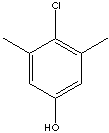| CAS
NO. |
88-04-0 |

|
| EINECS NO. |
201-793-8 |
| FORMULA |
ClC6H2(CH3)2OH |
| MOL
WT. |
156.61 |
|
H.S.
CODE
|
|
|
SMILES |
|
|
TOXICITY
|
Oral rat LD50:
3830 mg/kg |
| SYNONYMS |
3,5-Dimethyl-4-chlorophenol; Benzytol;
Chloroxylenol;
|
|
p-Chloro-m-Xylenol;
PCMX; 4-chloro-3,5-dimethyl phenol; 4-chloro-m-xylenol;
Chloroxylenol; 2-Chloro-m-xylenol; 2-Chloro-5-hydroxy-1,3-dimethylbenzene;
2-Chloro-5-hydroxy-m-xylene;
|
|
CLASSIFICATION
|
DISINFECTANTS
/
|
|
PHYSICAL AND CHEMICAL PROPERTIES
|
| PHYSICAL
STATE |
white
to off-white crystalline powder
|
| MELTING POINT |
113 - 116 C |
| BOILING
POINT |
246
C |
| SPECIFIC GRAVITY |
|
| SOLUBILITY
IN WATER |
Slightly soluble |
| pH |
|
| VAPOR DENSITY |
|
|
AUTOIGNITION
|
|
|
NFPA
RATINGS
|
Health: 1; Flammability: 1; Reactivity: 0 |
|
REFRACTIVE
INDEX
|
|
| FLASH
POINT |
|
| STABILITY |
Stable
under ordinary conditions. |
|
APPLICATIONS
|
|
Xylenols
are used in formulating a disinfectant for
lubricants, gasolines and coal tar. It is
used as an intermedaite for pesticides,
dyes, rubber chemicals and pharmaceuticals.
4-Chloro-3,5-xylenol
is used in formulating bactericides and
biocides with wide range of surfactants,
chlorinated phenols, sulphur and quaternary
ammonium compounds. It's
end applicartions include medicals and household
goods. It is used
as a preservatives for coatings, slurries and to control microbial fouling
in paper mills , oil field and leather process and water treatment
process against microbial
attack. |
| SALES
SPECIFICATION |
|
APPEARANCE
|
white to
off-white crystalline
powder |
|
ASSAY
|
98.5%
min
|
|
MELTING POINT |
113 - 116 C |
|
MOISTURE |
0.5% max |
| TRANSPORTATION |
| PACKING |
25kgs
in fiber drum |
| HAZARD CLASS |
|
| UN
NO. |
|
| OTHER
INFORMATION |
|
Hazard
Symbols: XI , Risk Phrases: 36/37/38, Safety Phrases: 28A/37/45 |
|
CHLORO-PHENOL COMPOUNDS |
|
Chlorinated phenol
compounds are toxic,
colourless, weakly acidic, one or more of the chlorine atoms attached to the
benzene ring of phenol. All chlorophenols are solids but only 2-chlorophenol is
a liquid. The most general property toxicity is useful. They and compounds made
from them are used as a bactericide and fungicide and preservative. 4-Chlorophenol a starting material for making germicides
such as 2-Benzyl-4-chlorophenol; it can also be converted to an analgesic of
acetophenetidin. 2,4-Dichlorophenol and formaldehyde form methylenebis compounds
used as a mothproofing agent, an antiseptic, and a seed disinfectant;
2,4-dichlorophenol, with chloroacetic acid, forms 2,4-Dichlorophenoxyacetic acid
(2,4-D), used as a selective weed-killer,
systemic herbicide and defoliant, also used to increase the latex output of old
rubber trees and in fruit drop control. trichlorophenols. 2,4,6-Trichlorophenol is used as a
bactericide and fungicide. The 2,4,5-isomer has similar applications and also
can be converted into Hexachlorophene or Thiobis(trichlorophenol) used as
germicides in soap. and into Dimethyl trichlorophenyl phosphorothioate, a
systemic agent effective against grubs in cattle; and into
2,4,5-Trichlorophenoxyacetic acid (2,4,5-T) or 2,4,5-Trichlorophenoxypropionic
acid (2,4,5-TCPPA), both widely used as weed killers. Tetrachlorophenol is an insecticide and a bactericide
and is used as a preservative for latex, wood, and leather. |
|
PRICE |
|

|
